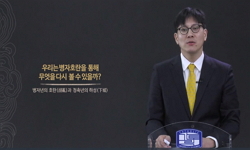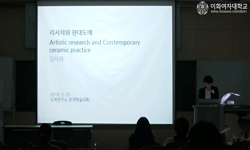朝鮮時代 白磁는 高麗時代 靑磁와 朝鮮時代 粉靑沙器와 더불어 韓國 陶磁史에서 중요한 비중을 차지하고 있다. 고려시대를 풍미했던 佛敎가 말기에 가까워지면서 여러 가지 폐단을 드러내...
http://chineseinput.net/에서 pinyin(병음)방식으로 중국어를 변환할 수 있습니다.
변환된 중국어를 복사하여 사용하시면 됩니다.
- 中文 을 입력하시려면 zhongwen을 입력하시고 space를누르시면됩니다.
- 北京 을 입력하시려면 beijing을 입력하시고 space를 누르시면 됩니다.
https://www.riss.kr/link?id=T11393295
- 저자
-
발행사항
대구 : 계명대학교 대학원, 2008
-
학위논문사항
학위논문(박사)-- 계명대학교 대학원 : 미술디자인학과 2008. 8
-
발행연도
2008
-
작성언어
한국어
- 주제어
-
발행국(도시)
대구
-
기타서명
(A) Study on the Aesthetic Sense Appearing in the White Porcelain of the Chosun Dynasty
-
형태사항
ⅴ, 240 p. : 삽도, 도판 ; 26 cm.
-
일반주기명
지도교수: 김임수
도판목록: p. 216-232
참고문헌: p. 204-215 - 소장기관
-
0
상세조회 -
0
다운로드
부가정보
국문 초록 (Abstract)
朝鮮時代 白磁는 高麗時代 靑磁와 朝鮮時代 粉靑沙器와 더불어 韓國 陶磁史에서 중요한 비중을 차지하고 있다. 고려시대를 풍미했던 佛敎가 말기에 가까워지면서 여러 가지 폐단을 드러내고, 당시 元을 통해 도입된 朱子學에 의해 점차 세력이 꺾이게 되면서 朝鮮時代에 들어서는 儒敎가 정치적?제도적?문화적 및 思想的으로 지배적 위치를 차지하게 된다. 이러한 변화는 陶磁史에도 일대의 전환점을 가져다주게 된다.
朝鮮白磁는 韓國 陶磁史에서 가장 한국적인 조형을 창출하여 단순, 간결한 아름다움의 극치를 보여준 양식이며 준수한 모습의 고전이다. 白磁는 自我에 대한 성찰과 각성을 통해 새로운 경지를 개척하였고, 그에 따른 참신한 독창성은 當時代의 意志의 표현이었으므로, 내면적인 考察에 의해 朝鮮時代 白磁를 재조명해 볼 필요가 있다.
본 논문은 朝鮮白磁에 나타난 造形的 특징의 분석을 통해 객관적 美的 유형을 고찰해보고, 여기에 표출된 美感의 추출에 목적을 두고 있다. 이러한 탐구는 朝鮮白磁와 당시대 인간정신에 대한 이해의 폭을 넓힘과 동시에, 그 美感이 발현될 수 있었던 배경과 특징을 한국미술의 광범위한 美的 범주 안에서 파악하여, 그 개체성과 위상을 선명하게 드러내고자 하는 시도이다.
따라서 白磁의 이해는 外形的인 형태론과 함께, 그 속에 內在된 인간의 근원적인 意志를 규명함으로서 美意識이 포함된 白磁의 實體를 이해하는 것이 필수적인 과제가 된다. 朝鮮時代 “白磁를 통하여 한국인의 美意識은 어떻게 추출될 수 있을까” 이 질문은 本 論文이 추구해 가야 할 방법론적 과제이며 美意識으로 접근해 가는 기초적인 단계이다.
社會?思想史的 배경에서는 白磁와의 연계관계를 규명하는 한정된 범위 안에서 性理學과 實學思想이 朝鮮時代 白磁에 미친 영향이 當時代에 어떠한 영향을 끼쳤는가 하는 문제를 살펴보았다. 朝鮮白磁를 규명하는데 성리학과 실학의 문제를 다루지 않을 수 없었던 것은 朝鮮白磁의 陶磁觀에 깊은 영향을 끼쳤기 때문이다. 이것이 함께 규명되어야만 白磁의 美的특징을 보다 명확하게 밝힐 수 있다고 생각하였다.
白磁의 조형성은 朝鮮時代 생활용기였다는 점과 그 시대의 美를 대표한다는 점을 감안 할 때, 유교 국가였던 朝鮮的 美의 가치기준에 따라 조금씩 그 양식을 달리하고 있음을 알 수 있다. 또한 이와 같은 변화에도 불구하고 항상 근저를 이루는 白磁의 造形的 특징은 본 논문의 중심이라고 할 수 있는 美意識을 연구하는데 기본 전제이므로 色, 器形, 紋樣 등의 특성을 개별적으로 분석하여 美的특징을 추출해보았다.
朝鮮白磁는 儒敎的 관념과 美意識이 담긴 고도의 정신적 대상이며, 여기에 나타난 본질은 사물의 物性을 완벽하게 이해하고 자신들이 추구하는 이념을 담담하게 표현한 자신감에서 찾을 수 있다. 극도로 정제된 재료의 강하면서도 부드러운 질감, 造形의 원천을 이루는 엄정한 線과 절제된 색상의 발견 없이는 완성될 수 없었기 때문이다. 이처럼 白磁가 지녔던 보편적 생활의 가치와 함께 自然主義的 心性, 잠재된 엄정하고 節制된 造形性, 無我의 정신, 線의 力動性이 朝鮮時代 白磁의 진정한 美學정신이라 할 수 있다.
白磁의 造形的 특징을 통해 표출된 美的특징을 논하였다. 自然美, 節制의 美, 無我의 美, 剛健美 등의 美的특징들은 白磁를 제작하고, 사용하고, 감상할 때 활용했던 판단기준이라 할 수 있다. 이러한 美的가치를 기준으로 형성된 白磁에 대한 美的태도가 당시대인들이 가졌던 美意識이라 할 수 있으며, 이 美意識이 朝鮮時代 白磁에서 造形意志로서 작용하였다.
다국어 초록 (Multilingual Abstract)
The White Porcelain of the Chosun Dynasty occupies an important place in the history of Korean ceramics together with the Celadon of the Koryo Dynasty and the Punch´ong of the Chosun Dynasty. With Buddhism, which dominated the Koryo Dynasty approachi...
The White Porcelain of the Chosun Dynasty occupies an important place in the history of Korean ceramics together with the Celadon of the Koryo Dynasty and the Punch´ong of the Chosun Dynasty. With Buddhism, which dominated the Koryo Dynasty approaching the end, it showed many evils and its influence came to be broken by the Zhu Xi school of New-Confucianism introduced through the Yuan Dynasty. With the beginning of the Chosun Dynasty, Confucianism came to occupy a ruling place in the areas of politics, systems, cultures, and ideas. These changes became a great turning point in the history of ceramics, too.
The White Porcelain of the Chosun Dynasty demonstrated the height of simplicity and compactness by creating the moulding, showing the height of Korean style and became the classic of the superior elegance. The White Porcelain of this period struck of a new path through the reflection and awakening of the self, and as the novel originality it produced was the expression of the will of the people of the period. It is necessary to illuminate it again through the introspection.
This study aims to examine the objective aesthetic points by analyzing the moulding characteristics appearing in the White Porcelain of the Chosun Dynasty and to extract the aesthetic characteristics expressed therein. This study expands the understanding of the human mind of the period, and at the same time, attempts to express distinctly the individuality and the phase by examining the backgrounds and characteristics, in which the aesthetic sense could be revealed within the wide category of the Korean fine arts.
Thus, it is the requisite task to realize the reality containing the aesthetic sense in terms of the understanding of the White Porcelain of the Chosun Dynasty by examining the original will therein of human beings together with the external morphology. How to extract the aesthetic sense of the Koreans through the White Porcelain of the Chosun Dynasty of the 18th century is the methodological task which this study will pursue and can be said to be the basic step to be approached in terms of the aesthetic sense.
Social and ideologic backgrounds were examined within the limited category of examining the link with the White Porcelain. How the influence of the Sung Confucianism and the Realism on White Porcelain influenced the period has also been examined. It is necessary to examine the matters of the Sung Confucianism and the Realism in examining the White Porcelain of the Chosun Dynasty since the ideas of the ceramics were formed by those in the early days of the Chosun Dynasty.
The formative characteristics were separately analyzed and explored according to the formative factors including the color of the glaze, the visage of pottery, the patterns and so on. It is found that the formativity of the White Porcelain shows somewhat different styles according to the standards of values of beauty of a Confucian country like the Chosun Dynasty, considering that it was the vessel for living and represented the beauty of the times. In spite of the changes like these, the formative characteristics of the White Porcelain lying at its bottom becomes the proposition in the study of the aesthetic sense which can be called the central theme of this study.
The White Porcelain of the Chosun Dynasty is a highly thought provoking object containing the Confucian ideas and aesthetic sense and the essences appearing here can be discovered in the confidence with which they understood the physical properties perfectly and expressed in a serene state of mind the ideas they were pursuing. It is because it could not be accomplished without finding the strong and soft feel of materials highly refined and the exact lines and temperate tone of color forming the source of molding. It can be said that, in this manner, the latent exact and temperate formativity, the generativity of pure materials and the consciousness of adaptation to nature, together with the universal values of living which the White Porcelain had, are the true aesthetic spirit of the White Porcelain of the Chosun Dynasty.
The aesthetic characteristics extracted through the formative characteristics of White Porcelain have been examined. It can be said that the aesthetic characteristics such as the beauty of the nature, the beauty of temperance, the beauty of detachment, the beauty of virility, the beauty of humor and so on were the criteria which the people of the times utilized in making, using and appreciating White Porcelain. The aesthetic attitudes formed on the basis of these aesthetic values can be said the aesthetic sense of the people of the times and this aesthetic sense acted on the moulding of White Porcelain of the Chosun Dynasty as the moulding purpose.
목차 (Table of Contents)
- Ⅰ. 序論 = 1
- 1. 硏究의 意義와 目的 = 1
- 2. 硏究方法 및 內容 = 4
- Ⅱ. 朝鮮白磁의 形成背景과 變遷過程 = 8
- 1. 朝鮮白磁의 形成背景 = 8
- Ⅰ. 序論 = 1
- 1. 硏究의 意義와 目的 = 1
- 2. 硏究方法 및 內容 = 4
- Ⅱ. 朝鮮白磁의 形成背景과 變遷過程 = 8
- 1. 朝鮮白磁의 形成背景 = 8
- 1) 白磁의 淵源 = 8
- 2) 朝鮮白磁의 形成背景 = 13
- 2. 朝鮮白磁의 變遷過程 = 19
- 1) 前期 (1392년-1649년) = 20
- 2) 中期 (1650년-1751년) = 27
- 3) 後期 (1752년-1910년) = 37
- Ⅲ. 朝鮮白磁의 社會·思想的 背景 = 47
- 1. 朝鮮白磁의 社會·文化的 背景 = 47
- 2. 性理學과 陶磁文化 = 57
- 3. 實學思想과 陶磁文化 = 67
- Ⅳ. 朝鮮白磁의 造形的 特徵 = 81
- 1. 色 = 82
- 2. 器形 = 98
- 3. 紋樣 = 109
- Ⅴ. 朝鮮白磁에 나타난 美的 特徵 = 123
- 1. 自然美 = 125
- 2. 節制의 美 = 143
- 3. 無我의 美 = 158
- 4. 剛健美 = 175
- Ⅵ. 朝鮮白磁에 나타난 美的 特徵의 意味 = 189
- Ⅶ. 結論 = 198
- 參考文獻 = 204
- 도판목록 = 216
- 영문초록 = 233
- 국문초록 = 238












